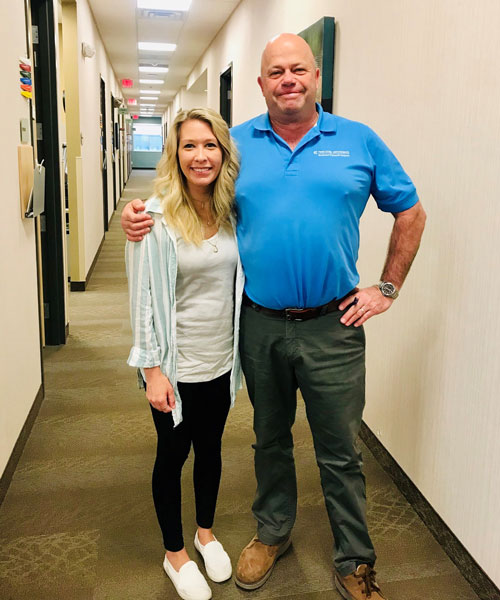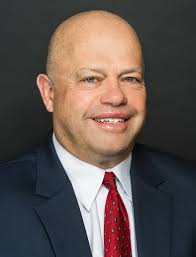Katie Karna doesn’t remember a time in her life when she didn’t have back pain. In 2002, she was diagnosed with Spondylolisthesis, a slipping of vertebra at the base of the spine. It was at that time she was told it was a matter of when — not if — she’d need to have surgery.
 “I was shocked, but I was young and still felt invincible,” says Karna. Years went by of living with the day-to-day discomfort, as well as a few significant flare-ups, including a bulged disc that took her out of work for a period of time. But it was two years ago, when she was doing yard work at home, that things really took a turn.
“I was shocked, but I was young and still felt invincible,” says Karna. Years went by of living with the day-to-day discomfort, as well as a few significant flare-ups, including a bulged disc that took her out of work for a period of time. But it was two years ago, when she was doing yard work at home, that things really took a turn.
“It just felt different and had deteriorated from that point on,” says Karna. “I was constantly exhausted and couldn’t do anything without pinching nerves in my back. Simple household chores were no longer easy for me because of the amount of pain I was in.”
She had a series of MRIs, went through physical therapy and tried steroid injections, but nothing worked. Due to the lack of answers and a pile of medical bills that had accumulated, Karna accepted that she was always going to feel this pain — until she noticed her symptoms had extended to her nerves.
She began to have tingling down her legs and through her feet and toes, which is when she made an appointment at Twin Cities Orthopedics (TCO) and was told the day had come when she’d need to have surgery.
“It was a very emotional experience for me, being told that,” says Karna. “All these years I’d known it was going to have to happen, but this time it was the reality of it — this was going to happen whether or not I was ready for it.”
She was referred to Dr. Paul Crowe, an orthopedic surgeon with TCO who operates at Maple Grove Hospital. At this point, Karna could barely stand, she was walking with a limp and having a hard time using the stairs.
The day of her surgery, Karna describes herself as feeling surprisingly calm. “I had a lot of confidence in Dr. Crowe,” says Karna. “I put my faith in him and knew that it would be OK. And the hospital team was so kind to me.”
Karna had a Posterior Bilateral Lumbar Fusion, a surgery that loosened the pinching and corrected the shifting that was happening with her L5 vertebra. Dr. Crowe, who specializes in and has been performing lumbar spine procedures for 30 years, says the surgery results are dramatically better than they were even five years ago. Complication rates are also way down, both of which are due to improvements in imaging, magnification and lighting.
Imaging, such as x-rays and MRIs, is essential to an accurate diagnosis, which you need to have before you can plan a correction.
“I see so many people who come in without a diagnosis and have been struggling, just trying this or that,” says Dr. Crowe. “Without a diagnosis, it’s luck if you get better. We first work on getting an accurate diagnosis and then we put together a treatment plan.”
Treatment typically starts with therapy, which is effective for most patients. However, about 20 percent still need some form of surgery. Dr. Crowe has a comprehensive team in place at TCO, with a physician assistant dedicated to education, a pain doctor for injections and spine-specialized therapists.
For those like Karna who need surgery, the procedure ranges from 1 to 2.5 hours, and the typical hospital stay is one to two nights. Patients are restricted in their activity for two weeks, are seen for a follow up visit after a month, and then start therapy if necessary. In all, Dr. Crowe’s patients are typically under his care for about eight weeks.
“Spine fusion is a major surgery, but with the modern techniques, the success rate is quite high,” says Dr. Crowe. “So, I say it’s major, but it’s not risky.”
When Karna came to after her surgery, she saw a Maple Grove Hospital team member sitting by her bedside; she instantly felt calmed and supported, remembering that she had told the nurses prior to her surgery that she had a fear of waking up alone and being confused.
“I had so many great nurses there,” says Karna. “I pressed the button all the time; they always came right away to help with whatever I needed. My experience was so wonderful that Maple Grove Hospital has become my go-to hospital.”
Now, less than a year after her surgery, Karna is completely pain-free.
“I feel like Dr. Crowe gave me a new life,” says Karna. “I can’t believe I get to wake up every day and I’m not fighting to get through the day because I’m in so much pain. I didn’t realize how bad the mental agony was for me — I was constantly thinking about it and trying to modify everything I did.”
Karna has put together a travel bucket list and every year on her surgery date, May 17, she vows she’s going to be somewhere different, checking another item off that list. “It’s going to be amazing,” says Karna. “I’m excited for the future.”
Dr. Paul Crowe's Advice for Maintaining a Healthy Spine
 According to Dr. Crowe, there are three main contributors to poor spine health:
According to Dr. Crowe, there are three main contributors to poor spine health:
- tobacco use
- excess weight
- lack of physical activity
“I think it’s pretty rare that anyone goes through their whole life without any back problems,” says Dr. Crowe. “If you want to prevent it from becoming what your life is about, then this is what I’d recommend everyone do: stop smoking, maintain a healthy weight and engage in regular exercise. Also, learn how to lift with your legs, not your back.”
Among other negative health effects, smoking interferes with the circulation of your discs. As far as exercise, increasing core strength is particularly important. You need strength in your muscles to help protect against wear and tear, and too much body weight is hard on your structures and causes degeneration. Generally exercising for joint mobility is helpful, too, as your back experiences less stress if your hips and knees are moving well.
“No matter your age or what other problems you have, these efforts can maximize your ability to maintain a functioning lifestyle,” says Dr. Crowe. “Life is motion, and for good motion, you need a painless spine.”

